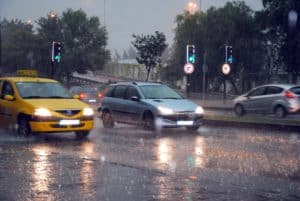
Driving in the rain can be slow moving. This can lead to people becoming impatient. While rain isn’t always dangerous, it’s riskier to drive in than a normal sunny day.
Related: Tips For Driving In The Rain
What is hydroplaning?
Hydroplaning occurs when a car loses traction on wet roads and its tires are unable to get traction on the road. Water is instead pushed under the tire which causes it to separate from the road. This is dangerous as the driver loses control of the vehicle while it slides.
Four hydroplaning safety tips
Poor weather conditions such as: rain, fog, ice and snow increase the chances of hydroplaning. However, motorists can protect themselves by practicing safe driving habits. Here are four safety tips to remember when the roads are wet:
- Slow down – Drive slower than usual, especially when visibility is low. Hydroplaning often occurs because vehicles were going too fast and were unable to regain control of the vehicle. Also, don’t be fooled by puddles. They are usually deeper than they appear. Avoid even the small ones as they can cause you to lose control of your vehicle. Try to keep in mind that water tends to accumulate on the sides of roads and highways. Also, refrain from stomping on the gas or brake pedal. Instead, gradually press your foot down on the gas or brake pedal.
- Stay calm – This one is important. Once you are behind the wheel, you are not just responsible for your safety, but you are also responsible for the safety of others. When your car skids, do not slam on the brakes. Ease your foot off the gas instead and turn the wheel into the direction you want your car to travel.
- Don’t brake suddenly – Pushing hard on the brake pedal will not help. The car has already lost steering control. Remove your foot from the pedal and bring it back once the vehicle slows down and you start to feel the road again. If you need to brake, do it gently (brake normally if your car has anti-lock brakes). Most importantly, remember to test your brakes afterwards to make sure they still work properly.
- Inflate tires – Poor traction increases your chances of hydroplaning. Check the owner’s manual and ensure that your tires are properly inflated and have good tread. Replace worn tires immediately. If you can’t replace or inflate your tires right away, consider carpooling, commuting or using another vehicle.
Related: Tips For Driving Safely in Snow and Ice
As a Kentucky Car Accident Attorney, I know how hard it can be to remain calm when you are driving, especially in bad weather. When something unexpected occurs, like hydroplaning, it can make you nervous. Remember to always check your tires, know what’s around you and don’t drive fast. Wet roads often trigger more vehicle crashes because drivers treat wet roads the same way they do dry roads. That’s a mistake. Your safety can never be compromised. Please slow down and drive carefully.
How to prevent hydroplaning
Here are a few ways to help prevent hydroplaning:
- Know what hydroplaning is and how it is caused. Hydroplaning is when there is enough water on the road that it will not allow your tires to channel the water away. This could be as little as a few inches. This results in the tires losing friction/contact with the road.
- Keep good tires on your car with that appropriate pressure in them.
- Slow down when it is raining.
- Avoid puddles. It is hard to judge how deep they are, and how much water there is in them. It is best to avoid them. If you can’t avoid them, go through them slowly.
- Don’t make sharp turns.
- Don’t use your cruise control feature on your car. If you are using this feature in the rain and decide to hit the brake to end the use of the cruise control that could cause you to hydroplane.
- Do not slam on your brakes. It may make your brakes lock up, you to lose traction and control over your vehicle. Instead, ease off the accelerator and your car will find traction.
- If you are behind another vehicle, follow their tracks. Their tires will displace the water, so yours won’t need to. However, remember not to follow them too closely.


